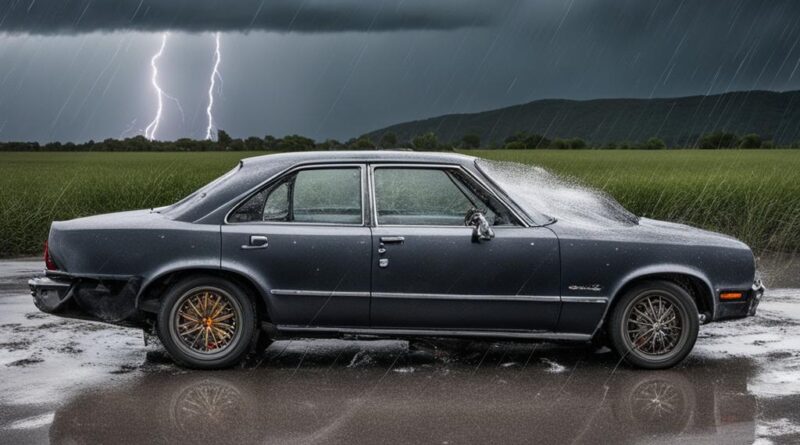Can Hail Damage Total a Car? Effects & Insurance Info.
Hail damage to a car can range from minor dents to extensive damage that results in a total loss. The severity and size of the hailstones, as well as the vulnerability of the car’s materials, can impact whether it is deemed a total loss. Hail can cause dents, broken windows, and paint damage, affecting both the appearance and functionality of a vehicle.
When it comes to repairing hail damage, it’s important to understand the potential financial impact. Not all insurance policies cover hail damage repairs, so you’ll need to evaluate your car insurance coverage to determine if you have comprehensive insurance. Keep in mind that if the cost of repairs exceeds a certain percentage of your car’s value, it may be considered a total loss.
In this article, we’ll explore the factors that determine whether hail damage totals a car, the impact of hail damage on car value, insurance coverage for hail damage, the potential impact on insurance rates, and more. Whether you’re dealing with hail damage or want to be prepared for the future, this information will help you navigate the process effectively.
Key Takeaways:
- Hail damage can range from minor to extensive and can lead to a car being considered a total loss.
- The severity and size of the hailstones, as well as the vulnerability of the car’s materials, can impact whether it is deemed a total loss.
- Not all insurance policies cover hail damage repairs, so it’s important to understand your car insurance coverage.
- Insurance rates may increase when hail damage repairs exceed a certain percentage of the vehicle’s value.
- Taking proactive measures to prevent hail damage, such as parking in a protected area or using a hail-resistant cover, is recommended.
Factors that Determine whether Hail Damage Totals a Car
Whether hail damage totals a car depends on various factors that contribute to the extent of the damage. Understanding these factors can help car owners assess the severity of the hail damage and determine the necessary steps for repair or replacement.
The severity and size of the hailstones are crucial factors in determining the level of damage. Larger hailstones have a higher impact force, resulting in more substantial damage to the vehicle’s exterior. The vulnerability of the car’s materials also plays a significant role. Vehicles with more fragile materials, such as older models or those made of lightweight materials, are more prone to extensive damage from hailstones.
The extent of damage to the vehicle’s body panels and structural components is another key consideration. If the hail has caused significant damage to multiple body panels or structural components, the repair costs may exceed the vehicle’s value, making it more likely to be deemed a total loss.
Visible hail denting and cracking are clear indications of the severity of the damage. These visible signs can help assess the overall condition of the car and determine the necessary repairs. In some cases, the presence of holes in the vehicle due to hailstones can further contribute to the determination of a total loss.
Widespread damage throughout the car can also be a factor in deciding whether hail damage totals the vehicle. If the damage is extensive and affects various components and areas of the car, repairs may be too costly or impractical, making it more likely that the car will be declared a total loss.
| Severity Level | Description |
|---|---|
| Minor | Small dents and scratches |
| Moderate | Dents and cracks in body panels |
| Severe | Large dents, shattered windows, and extensive structural damage |
Impact of Hail Damage on Car Value
When a car is considered a total loss due to hail damage, it can have a significant impact on the vehicle’s value. Insurance companies calculate the value of the car by assessing the damage and recalculating its worth based on the estimated fair market value of a comparable vehicle.
An insurance adjuster will carefully evaluate the hail damage and consider various factors such as the extent of the damage, the age and condition of the car, and the local market value of similar vehicles. They aim to provide a fair assessment of the car’s value after the hail damage.
The insurance payment for a hail-damaged car is typically based on the fair market value of the vehicle. This means that the amount you receive may not cover the full cost of repairs or the original value of the car. It’s important to note that insurance policies may have deductibles that need to be met before receiving payment.
If the damaged car is leased, additional payments may be received based on the terms of the lease agreement. It’s essential to review the lease contract or consult with the leasing company to understand the potential financial implications of hail damage on a leased vehicle.
Working closely with the insurance company and providing any necessary documentation can help negotiate a fair value for the totaled car. It’s recommended to gather evidence of the car’s condition and market value, such as maintenance records and recent comparable sales in the area.
Overall, the impact of hail damage on a car’s value can be substantial. It’s important to understand the insurance adjuster assessment process and work to ensure fair compensation based on the current market value of the vehicle.
Insurance Coverage for Hail Damage
Hail damage is something that many car owners worry about, as it can cause significant harm to their vehicles. One way to protect yourself financially from hail damage is by having comprehensive insurance coverage. Comprehensive insurance, also known as “other than collision” coverage, extends beyond just accidents and covers a wide range of damages, including hail damage.
Comprehensive insurance coverage provides financial protection in the event of hail damage, as well as damages caused by animal strikes, vandalism, and theft. This means that if a hailstorm causes dents, cracks, or broken windows on your car, your insurance can help cover the cost of repairs.
To file a hail damage claim, you will typically need to pay your comprehensive deductible. The deductible is the amount you must contribute out of pocket before your insurance coverage kicks in. Once you’ve paid your deductible, you can begin the claim process.
Claim Process for Hail Damage
- Document the damage: Start by thoroughly documenting the hail damage on your car. Take clear photos from different angles to provide evidence of the extent of the damage.
- Get estimates: Reach out to trusted body shops and get multiple estimates for the repair costs. This will help you understand how much the repairs will cost and compare it to your deductible.
- Compare costs to deductible: Compare the estimated repair costs to your deductible. If the repair costs exceed your deductible, filing an insurance claim may be beneficial.
- File a comprehensive insurance claim: Contact your insurance company to file a comprehensive insurance claim. Provide them with the necessary documentation, including the photos of the damage and the repair estimates.
- Assessment by an insurance adjuster: An insurance adjuster will assess the hail damage on your car and determine whether the repairs can be approved or if it should be declared as a total loss.
It’s important to note that the hail damage claim process may vary slightly between insurance companies. However, following these steps will help ensure a smooth and efficient process for getting your hail damage repaired and covered by your insurance.
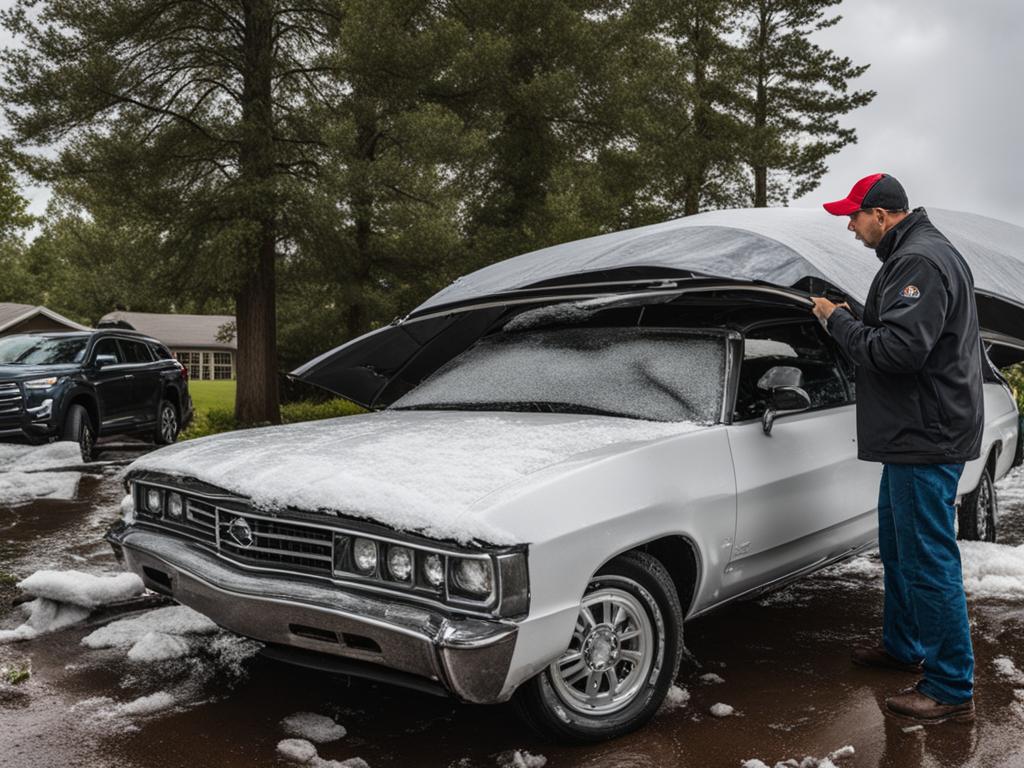
Impact on Insurance Rates
Comprehensive claims for hail damage generally do not have a direct impact on insurance rates. This is because damages caused by natural events, such as hailstorms, are considered unforeseeable and out of the policyholder’s control. Therefore, insurance companies typically do not hold these claims against the policyholder when determining insurance rates.
However, it is important to note that the total number of claims made on a policy can affect insurance rates. If multiple claims, including those for damages caused by natural events, have been filed recently, insurance companies may perceive the policyholder as a higher risk. As a result, the policyholder could face higher insurance premiums.
It’s worth mentioning that claims for damages caused by natural events, including hailstorms, are considered to be beyond the control of the policyholder. These events are often characterized as “acts of God” or unforeseeable occurrences. Insurance companies understand that policyholders cannot prevent or predict these events, and they take this into consideration when setting insurance rates.
Average Insurance Rates After Hail Damage Claims
| Number of Recent Hail Damage Claims | Impact on Insurance Rates |
|---|---|
| No recent claims | No significant impact |
| 1 recent hail damage claim | Minimal impact |
| Multiple recent hail damage claims | Possible increase in insurance premiums |
As shown in the table above, insurance rates remain relatively stable when there are no recent hail damage claims. Even a single recent hail damage claim may have minimal impact on insurance rates. However, multiple recent claims, whether related to hail damage or other types of damages, can potentially result in higher insurance premiums.
“Insurance companies take into account the total amount of claims affecting rates, including damages caused by natural events like hailstorms. While individual hail damage claims may not directly impact rates, multiple claims can result in higher insurance premiums.”
Average Hail Damage Claims and Costs
When it comes to hail damage claims, the average car insurance claim is $5,000, according to State Farm’s hail claims data. However, the actual amount that car insurance will pay out depends on the extent of the damage and the deductible. It’s essential to consider the repair costs and compare them to the deductible to determine if filing a claim is financially beneficial.
Repair costs for hail damage can vary considerably based on the severity of the damage. Minor dents and dings may require less expensive repairs, while larger dents or broken windows may increase the repair costs significantly. By getting estimates from trusted body shops, you can get a better understanding of the expected repair costs.
Let’s take a look at a table that breaks down the typical costs associated with hail damage repairs:
| Type of Repair | Cost Range |
|---|---|
| Minor dents and dings | $100 – $500 |
| Paintless dent repair | $500 – $1,500 |
| Window replacement | $200 – $800 |
| Total roof replacement | $2,000 – $6,000 |
Remember, this is just a rough estimate, and actual costs may vary depending on several factors such as the make and model of your car, the extent of the damage, and the labor rates in your location.
It’s crucial to keep in mind that filing a claim may come with a deductible. The deductible is the amount you’re responsible for paying out of pocket before your insurance kicks in. Check your policy to determine the deductible amount and evaluate whether filing a claim makes financial sense based on the repair costs and your deductible.
By carefully considering the repair costs and deductible, you can make an informed decision about filing a claim for hail damage. It’s always a good idea to consult with your insurance provider or agent to understand the specific details of your policy and how the claim process works.
High-Risk States for Hail Damage
Based on State Farm’s hail claims data, certain states are particularly prone to hail damage. In 2021, the top five high-risk states for hail damage were:
- Texas
- Minnesota
- Oklahoma
- Illinois
- Colorado
These states experienced a significant number of hail damage claims, leading to insurance payouts for both home and auto damage. Residents in these areas should be aware of the increased risk of hailstorms and take necessary precautions to protect their vehicles.
Understanding the prevalence of hail damage in these states can help individuals prepare for potential storms and minimize the impact on their vehicles. Taking proactive measures such as parking in covered areas or utilizing hail-resistant covers can provide added protection.
Hail Damage Claims in Top High-Risk States (2021)
| State | Number of Hail Damage Claims |
|---|---|
| Texas | 10,523 |
| Minnesota | 7,988 |
| Oklahoma | 7,449 |
| Illinois | 7,372 |
| Colorado | 6,816 |
Table 7: Hail Damage Claims in Top High-Risk States (2021)
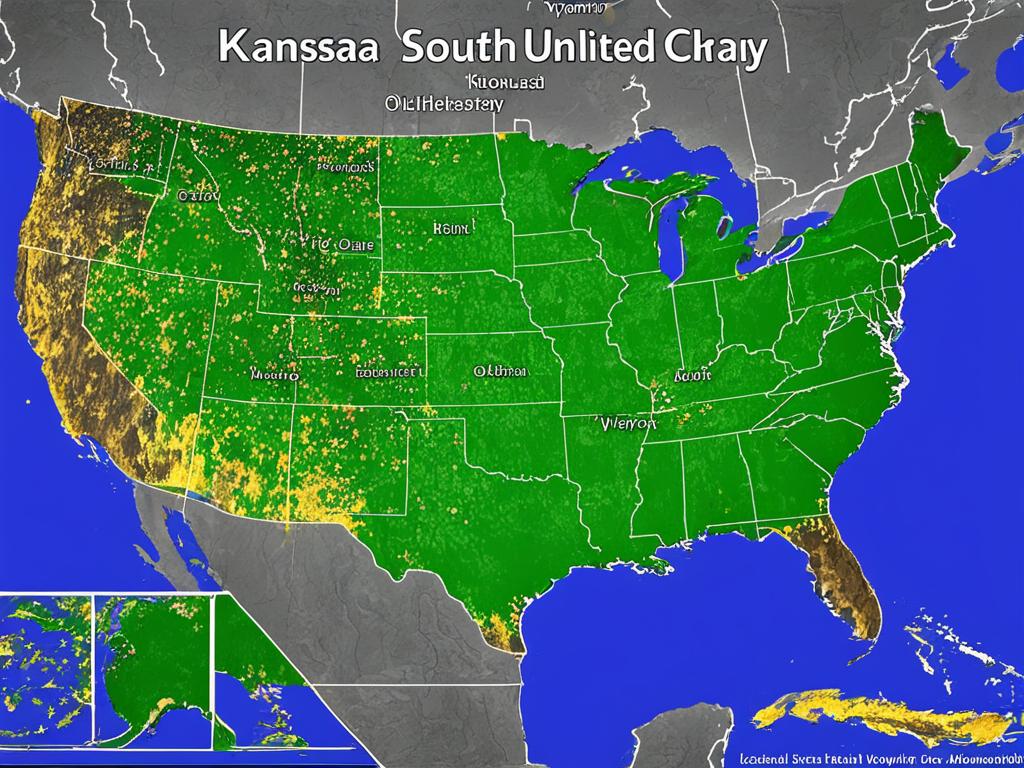
Preventing Hail Damage
Taking proactive steps to protect your car from hail damage is essential to avoid costly repairs. Here are some effective measures you can take:
Parking in a Garage or Indoor Parking Lot
Parking your car in a garage or indoor parking lot when hailstorms are predicted is the most reliable way to shield it from hail damage. This provides a secure and covered space that effectively safeguards your vehicle against hailstones.
Investing in a Hail-Resistant Cover
An additional layer of protection can be achieved by investing in a hail-resistant cover made from impact-resistant materials. These covers are specifically designed to endure hailstorms and minimize potential damage to your vehicle’s body.
Protecting Your Vehicle During Sudden Hailstorms
In situations where you don’t have access to a garage or a hail-resistant cover, having a plan in place to quickly cover and protect your car during sudden hailstorms is crucial. Keep mats or blankets readily available in your trunk to provide temporary cover until you can find a safe location.
By taking these preventative measures, you can significantly reduce the risk of hail damage to your vehicle and ensure its long-term integrity.
Importance of Comprehensive Insurance Coverage
Comprehensive insurance coverage is essential when it comes to protecting your vehicle against hail damage and other unforeseen circumstances. Unlike collision coverage, comprehensive coverage extends beyond accidents involving other vehicles and includes damages caused by hail, among other things. It provides you with financial security and peace of mind, knowing that you’re protected in case of hailstorms or other incidents.
When considering comprehensive insurance coverage, it’s important to work with an experienced insurance agent who can guide you through the process and help you select the best policy for your needs. Robinson and Stith Insurance is a trusted insurance agency that specializes in providing comprehensive coverage options to ensure that you have the necessary protection for your vehicle.
By choosing comprehensive insurance coverage, you can rest assured that your vehicle will be protected in the event of hail damage. This coverage helps to cover the costs of repairs and ensures that you won’t have to bear the entire financial burden on your own. Whether it’s small dents or significant damage, comprehensive coverage can help you get your vehicle back on the road without breaking the bank.
Why Choose Comprehensive Insurance Coverage:
- Protection against hail damage: Comprehensive coverage includes coverage for hail damage, ensuring that you’re financially protected if your vehicle is damaged in a hailstorm.
- Peace of mind: Knowing that your vehicle is protected against a wide range of risks, including hail damage, gives you peace of mind and allows you to drive with confidence.
- Financial security: With comprehensive coverage, you won’t have to worry about the high costs of repairing hail damage. Your insurance policy will help cover those costs, minimizing the financial impact on you.
- Working with an insurance agent: By working with an insurance agent like Robinson and Stith Insurance, you can get personalized assistance in navigating the different coverage options and selecting the policy that best fits your needs.
- Comprehensive coverage for other incidents: Comprehensive insurance coverage not only protects you against hail damage but also covers damages caused by theft, vandalism, fire, falling objects, and more.
When it comes to protecting your investment, comprehensive insurance coverage is a wise choice. By partnering with an insurance agent like Robinson and Stith Insurance, you can ensure that you have the right coverage in place to guard against unexpected situations, including hail damage to your vehicle.

Mistakes to Avoid with Hail Damage
Dealing with hail damage on your car can be a challenging situation. However, there are common mistakes that people make that can worsen the damage or result in financial setbacks. It’s important to be aware of these mistakes and take proactive steps to avoid them.
Underestimating the Damage
One common mistake is underestimating the extent of the hail damage. Even minor dents and dings can lead to more significant issues down the line, such as rust or paint damage. It’s essential to assess the damage accurately and not assume that it’s not significant.
Waiting to Get Repairs
Another mistake is waiting too long to get repairs for hail damage. By delaying repairs, you risk further damage to your car. Additionally, if the damage is extensive, your car may even be considered a total loss by your insurance company. It’s crucial to address the repairs promptly to minimize the risk of additional damage.
Blindly Following Insurance Company’s Instructions
It’s important to remember that you have options when it comes to hail damage repairs. While your insurance company may recommend specific repair shops, it’s essential to consider other options. Some preferred vendors may not provide the quality of work or advocacy that you need. Take the time to research and choose a repair shop that you trust.
Fear of Increased Premiums
Some car owners fear that filing a hail damage claim will result in increased insurance premiums. However, it’s important to understand that claims for damages caused by natural events like hailstorms are often considered unforeseeable and out of control. While the total number of claims can impact rates, individual claims for hail damage are less likely to affect your premiums.
Assuming All Repair Shops Are the Same
Not all repair shops are the same when it comes to hail damage repairs. Some shops may specialize in specific techniques or have experience working with insurance companies. It’s important to choose a repair shop that has the expertise and resources to handle your specific hail damage repair needs.
By avoiding these common mistakes, you can navigate the process of dealing with hail damage more effectively and ensure the best outcome for your car.
The Financial Impact of Light Hail Damage
Even light hail damage can have a significant financial impact on a car’s value. Although the damage may appear minor and hardly noticeable, it can still lead to a loss of value when it comes time to sell or trade in the vehicle. Repairing hail damage can be costly, ranging from a few hundred to several thousand dollars depending on the extent of the damage.
When considering the financial implications of hail damage, it’s important to take into account the potential loss of value. Buyers may be less inclined to purchase a car with visible hail damage, requiring you to lower the selling price or accept a lower trade-in value. Additionally, insurance companies may classify the vehicle as having pre-existing damage, which can further reduce its value.
Repairing the hail damage can help maintain the value of your car. By paying the insurance deductible and investing in repairs, you can mitigate the financial impact of the damage. It’s akin to safeguarding your savings account by addressing potential issues before they escalate. Just as you would protect your financial assets, protecting your car’s value is an essential consideration in managing the financial impact of hail damage.
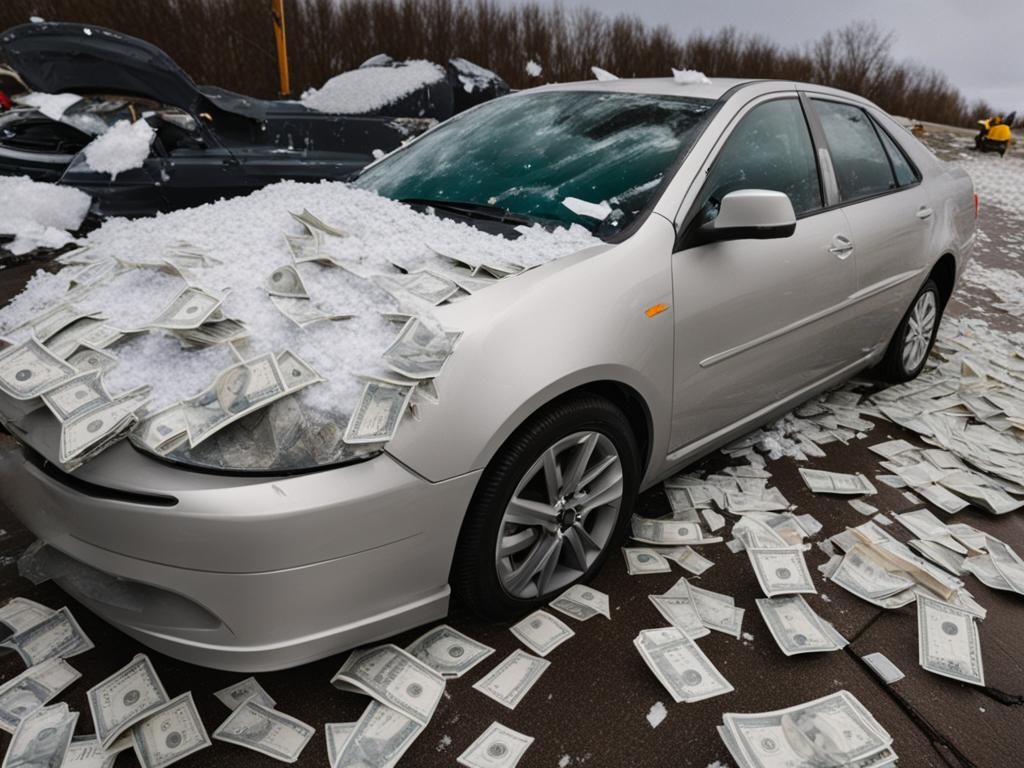
Repair Costs and Deductible:
The costs associated with repairing hail damage can vary depending on the severity and extent of the damage. Factors such as the size of the dents and the need for repainting can contribute to the overall repair expenses. It’s advisable to obtain estimates from reputable auto body repair shops to determine the precise cost of repairs.
When filing an insurance claim for hail damage, you will typically be required to pay a deductible. The deductible represents the amount you are responsible for before your insurance coverage kicks in. By paying the deductible and proceeding with the repairs, you can restore your car’s appearance and potentially minimize the financial impact of the damage.
Loss of Car Value:
The loss of car value resulting from hail damage can be a significant consideration for car owners. Even if the damage is superficial, it can affect a potential buyer’s perception of the vehicle’s overall condition and value. To maximize the value of your car, it’s crucial to address and repair any hail damage.
“Even minor hail damage can impact a car’s value. It’s important to repair the damage to maintain the resale or trade-in value of the vehicle.”
By investing in repairs or working with a reputable auto body repair shop, you can address the hail damage and help preserve your car’s value. This proactive approach can ensure that you receive fair compensation for your vehicle when the time comes to sell or trade it in.
In Summary:
- Hail damage, even if light, can have a significant financial impact on a car’s value.
- Repair costs for hail damage can range from a few hundred to several thousand dollars.
- Addressing hail damage through repairs can help maintain the value of your car.
- Paying the insurance deductible and investing in repairs is akin to protecting a savings account.
- Maximizing the value of your car requires addressing and repairing any hail damage.
Risks of Delaying Hail Damage Repairs
Delaying hail damage repairs can pose significant risks to your vehicle and your insurance claim. By neglecting to address hail damage promptly, you increase the likelihood of a potential total loss, further damage, and limitations on your insurance settlement. It’s important to understand these risks and take appropriate action to protect your vehicle and financial interests.
Potential Total Loss
When hail damage is left unaddressed, the metal of your car may sustain additional damage over time. This can reach a point where it becomes impossible to restore the vehicle’s original shape, potentially resulting in a total loss. By delaying repairs, you risk losing the opportunity to salvage your car and may have to bear the financial burden of purchasing a new one.
Pre-Existing Damage
Driving with pre-existing hail damage exposes your vehicle to further harm in the event of another hailstorm or an accident. The structural integrity of your car may be compromised, increasing the likelihood of more severe damage during subsequent incidents. By promptly repairing hail damage, you can mitigate the risk of exacerbating existing damage.
Exposure to Further Damage
Unrepaired hail damage leaves your car vulnerable to additional harm. Hailstorms can cause dents, cracks, and broken windows that can worsen over time as your vehicle is exposed to various weather conditions and road hazards. Timely repairs help protect your car from further damage and maintain its structural integrity.
Insurance Settlement Limitations
Insurance settlements for hail damage may have limitations if the damage is not repaired promptly. Insurance companies typically require policyholders to mitigate their losses and take reasonable steps to prevent further damage. Failing to comply with these requirements may result in reduced settlement amounts or coverage limitations. By promptly repairing hail damage, you maximize your chances of receiving a fair insurance settlement.
| Risks of Delaying Hail Damage Repairs |
|---|
| Potential Total Loss |
| Pre-Existing Damage |
| Exposure to Further Damage |
| Insurance Settlement Limitations |
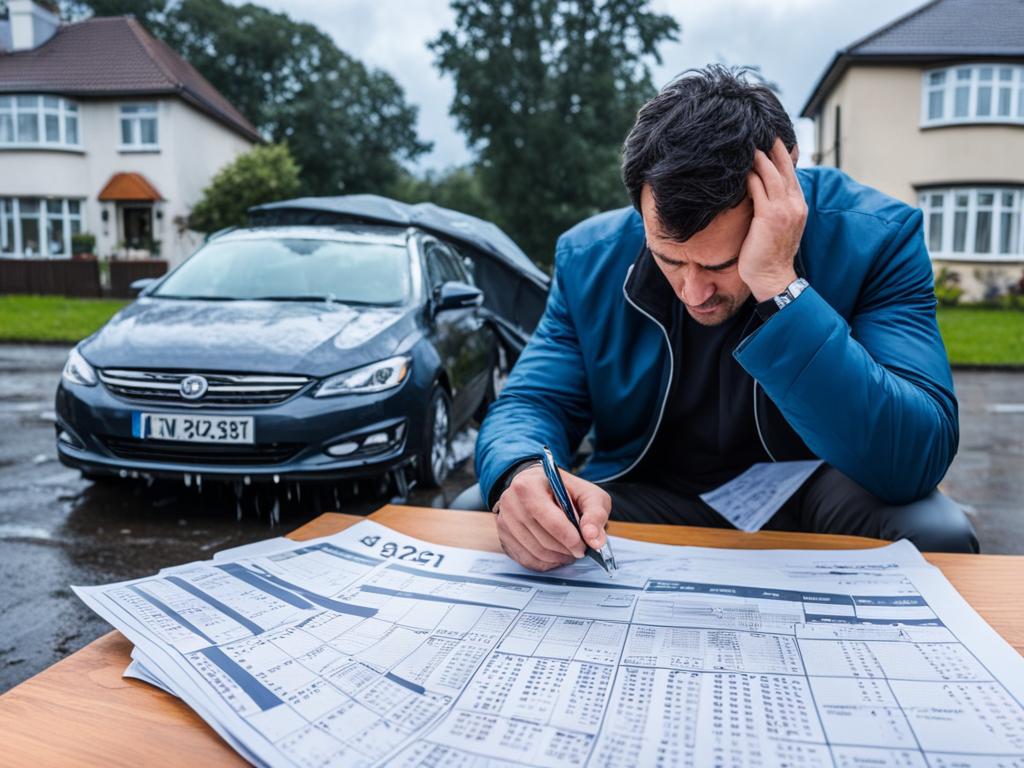
Choosing the Right Repair Shop
When it comes to repairing hail damage on your car, it’s essential to choose the right repair shop. While insurance companies may have preferred vendors, it’s worth considering independent shops that offer several advantages to the policyholder.
One of the advantages of choosing an independent shop is their willingness to assist with deductible payments or provide rental cars during the repair process. These additional services can ease the financial burden and inconvenience for the policyholder.
Furthermore, independent shops often prioritize the best outcome for the policyholder rather than solely following the insurance company’s preferred vendors. They advocate on behalf of the policyholder to ensure a fair assessment of the damage and a higher settlement offer from the insurance company.
To guarantee an accurate assessment, independent shops conduct thorough inspections and provide detailed estimates. They have the specialized equipment and expertise necessary to identify and document all hail damage, ensuring that no hidden or overlooked damage affects the repair process.
Overall, choosing an independent repair shop for hail damage repairs provides policyholders with more options, better advocacy, and a meticulous assessment that can lead to a higher settlement offer from the insurance company.
| Advantages of Choosing an Independent Shop |
|---|
| Assistance with deductible payments |
| Access to rental cars during repairs |
| Advocacy for the policyholder’s best interests |
| Thorough inspections and detailed estimates |
| Potential for a higher settlement offer from the insurance company |
The Role of Insurance Companies in Hail Damage Claims
When it comes to hail damage claims, insurance companies play a crucial role in the process. Understanding their involvement can help policyholders navigate the complexities and ensure a fair assessment and settlement. Here’s a breakdown of the insurance company’s role in hail damage claims:
Initial Estimates and Settlements
After filing a hail damage claim, an insurance adjuster will assess the damage to determine the extent of the loss. However, it’s important to note that initial estimates provided by adjusters may not always accurately reflect the full extent of the damage. Adjusters may miss hidden or underlying damages that can affect the repair costs. Policyholders should thoroughly review the initial estimate and assess whether it covers all necessary repairs.
Limits of Preferred Vendors
Insurance companies often have a list of preferred vendors for repairs. These preferred vendors are recommended by the insurance company for their quality of work and negotiated pricing. However, it’s essential to understand that using a preferred vendor may have limitations. The insurance company’s relationship with these vendors may impact the payment structure, potentially resulting in higher out-of-pocket expenses for the policyholder. Policyholders should carefully assess their options and consider consulting with independent repair shops.
Supplements for Additional Damages
In some cases, the initial estimate provided by the insurance adjuster may not cover all the damages caused by the hailstorm. Policyholders have the right to request supplements for additional damages that were not initially accounted for in the settlement. Supplemental claims can be filed to address any missed repairs or overlooked damages. Consulting with a reputable and experienced repair shop can help identify any additional damages that require supplemental claims.
Working with Reputable Repair Shops
Working with a reputable repair shop is crucial when dealing with hail damage claims. These repair shops can help policyholders navigate the insurance process and advocate for their best interests. They can provide a comprehensive assessment of the damage, ensure thorough documentation, and negotiate with the insurance company for a fair settlement. Policyholders should choose repair shops with a proven track record and a commitment to providing quality repairs.
Conclusion
In conclusion, hail damage can have a significant impact on a car’s value and overall insurance coverage is crucial for protection. Understanding the factors that determine whether hail damage totals a car and the claims process can help individuals navigate the situation effectively.
It is important to take proactive measures to prevent hail damage, such as parking in a protected area or using a hail-resistant cover. These proactive steps can greatly reduce the risk of hail damage and potential repairs.
When hail damage does occur, choosing the right repair shop is crucial. Working with a repair shop that advocates for the policyholder’s best interests can ensure a fair assessment and repair process. By selecting a reputable repair shop, individuals can have peace of mind knowing that their car will be properly evaluated and repaired to its pre-damage condition.
FAQ
Can hail damage total a car?
Hail damage can range from minor to extensive and can lead to a car being considered totaled. The severity and size of the hailstones, as well as the vulnerability of the car’s materials, can impact whether it is deemed a total loss.
What factors determine whether hail damage totals a car?
The severity and size of the hailstones, extent of damage to body panels and structural components, visible hail denting and cracking, presence of holes, and widespread damage can all contribute to a car being deemed a total loss.
How does hail damage impact a car’s value?
When a car is considered a total loss due to hail damage, the value of the vehicle is recalculated. An insurance adjuster will assess the damage and issue a payment based on the estimated fair market value of a comparable vehicle.
Is hail damage covered by insurance?
Hail damage is typically covered under comprehensive insurance coverage, also known as “other than collision” coverage. This coverage extends to damages caused by hail, as well as animal strikes, vandalism, and theft.
Does making a hail damage claim affect insurance rates?
Generally, comprehensive claims for hail damage do not directly affect insurance rates. However, the total number of claims made on a policy can impact rates, so it’s important to consider the overall claim history.
What is the average car insurance claim for hail damage?
According to State Farm’s hail claims data, the average car insurance claim for hail damage is $5,000. The actual amount that car insurance will pay depends on the extent of the damage and the deductible.
Which states have the highest hail damage claims?
Based on State Farm’s hail claims data, the top five states for hail damage claims in 2021 were Texas, Minnesota, Oklahoma, Illinois, and Colorado.
How can I prevent hail damage to my car?
Taking proactive steps such as parking the car in a garage or indoor parking lot when hail storms are predicted or investing in a hail-resistant cover can help protect the vehicle during hailstorms.
How important is comprehensive insurance coverage for hail damage?
Comprehensive insurance coverage is crucial for protecting against hail damage. Working with an insurance agent, such as Robinson and Stith Insurance, can ensure that individuals have the necessary coverage to protect their cars from hail damage and other unexpected situations.
What mistakes should I avoid when dealing with hail damage?
Common mistakes include underestimating the damage, waiting too long to get repairs, blindly following the instructions of the insurance company, fearing increased premiums, and assuming all repair shops are the same. It’s important to be aware of these mistakes and take proactive steps to avoid them.
Does even light hail damage have a significant financial impact?
Even light hail damage can have a significant financial impact on a car’s value. Repair costs for hail damage can range from a few hundred to several thousand dollars, depending on the extent of the damage.
What are the risks of delaying hail damage repairs?
Delaying hail damage repairs can increase the risk of a potential total loss, further damage to the vehicle, and limitations on insurance settlements if the damage is not repaired in a timely manner.
How do I choose the right repair shop for hail damage?
It’s important to consider alternatives to the insurance company’s preferred vendors. Independent shops can provide advantages such as helping with deductible payments or rental cars and working towards the best outcome for the policyholder.
What is the role of insurance companies in hail damage claims?
Insurance companies play a significant role in hail damage claims. Initial estimates and settlements provided by adjusters may not accurately reflect the full extent of the damage. Preferred vendors recommended by the insurance company may have limitations in terms of payments and services offered.
What is the summary of key points regarding hail damage?
Hail damage can have a significant impact on a car’s value. Insurance coverage is crucial for protection. Proactive measures can prevent damage. Choosing the right repair shop is important.

